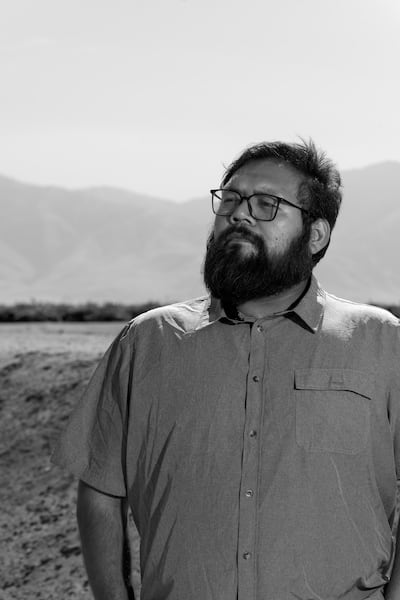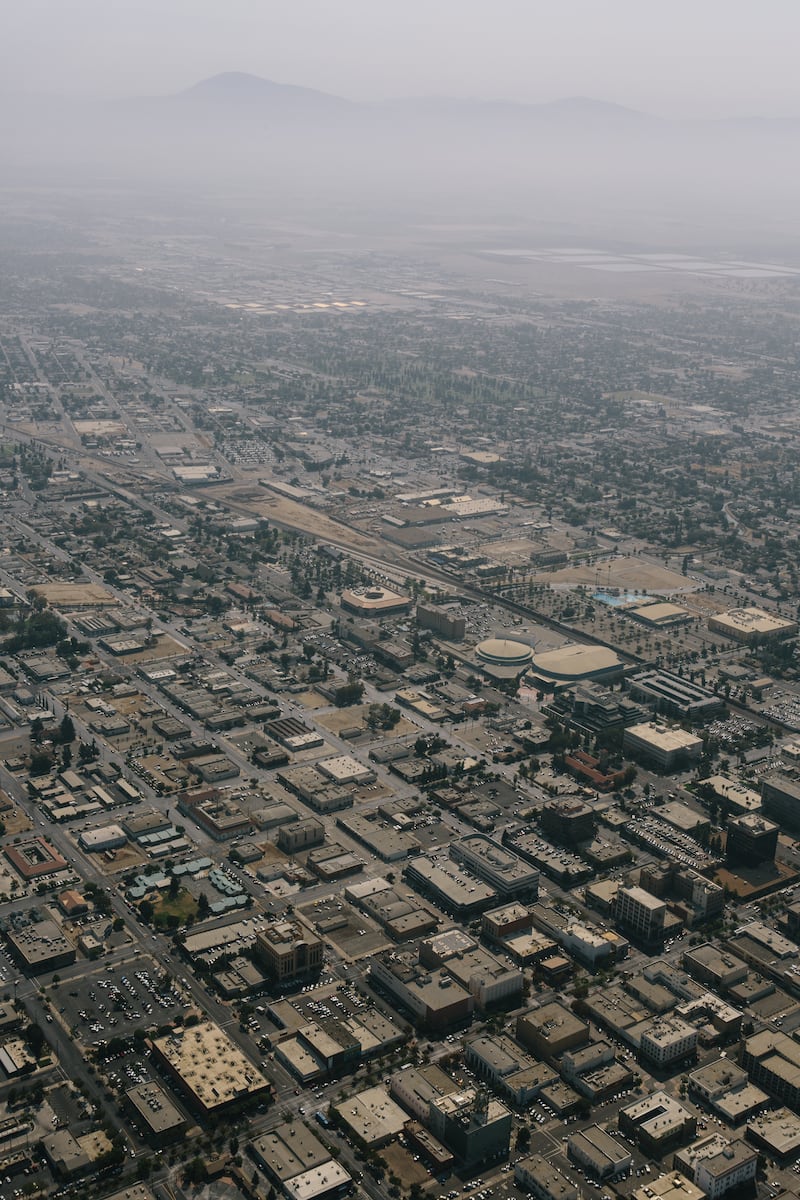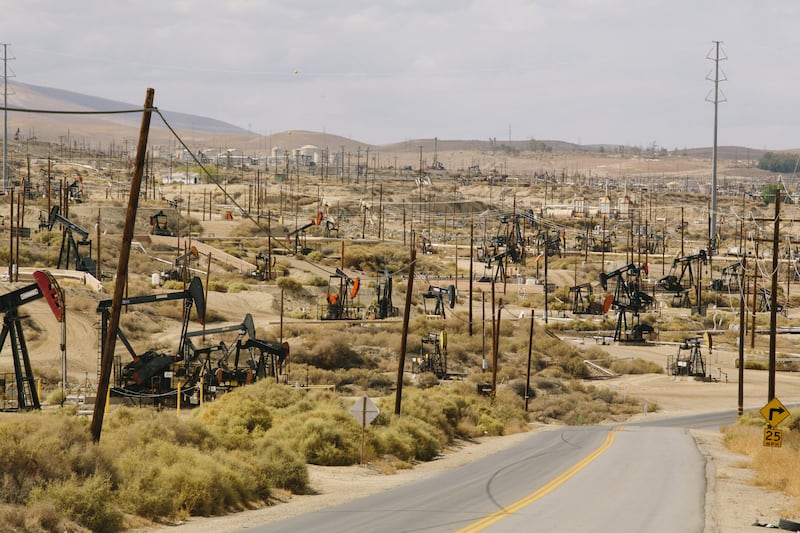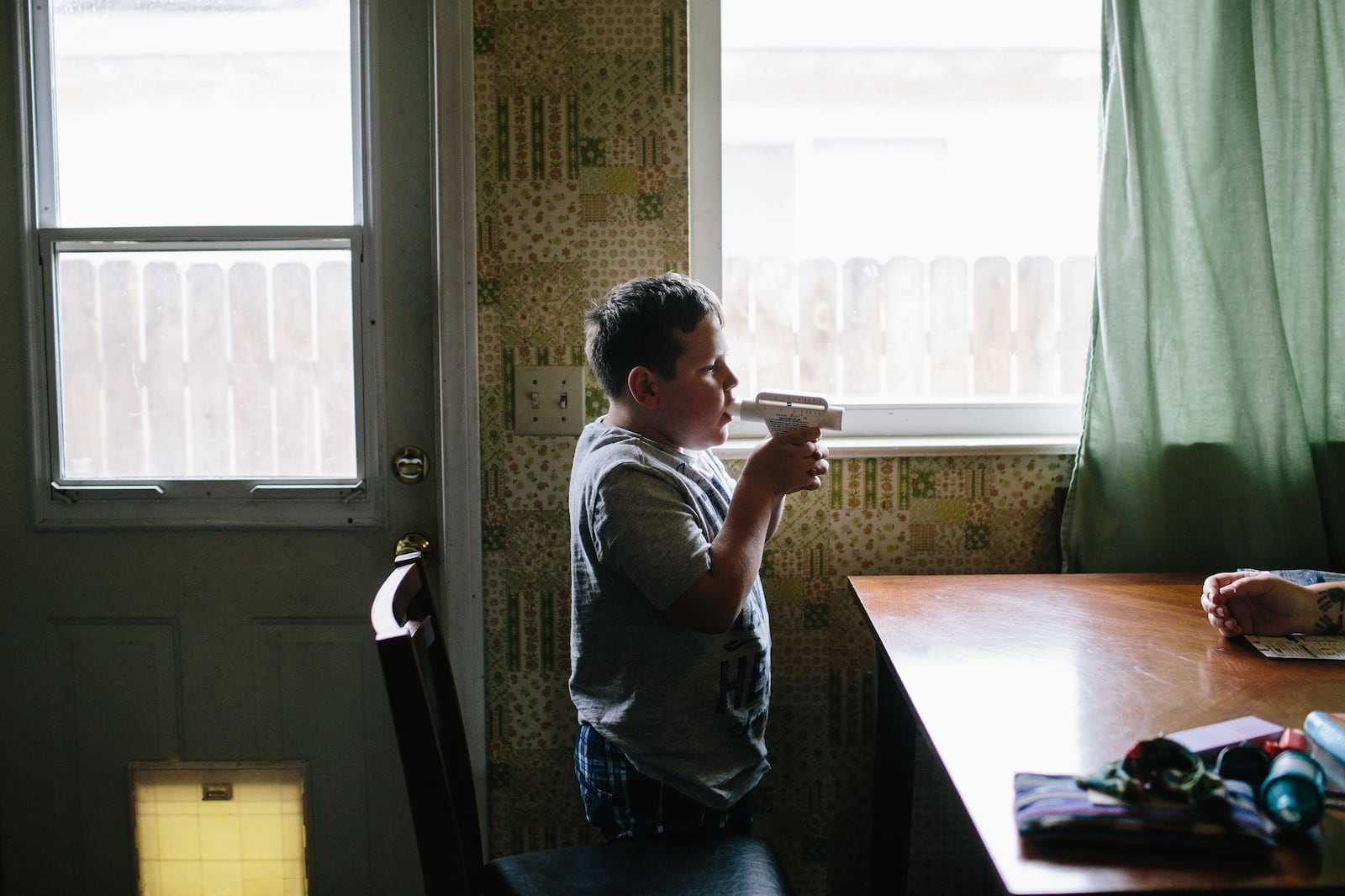Every night, not long after the sun drops below the dusty horizon on the outskirts of Bakersfield, Jesus Alonso begins the ritual of safely putting his 8-year-old son, also named Jesus, to bed.
In the same home he grew up in, in the same bedroom where he slept throughout his own adolescence, the older Jesus goes to his child’s bedside and sets him at a 45-degree angle, so his head is elevated, to help him breathe, and always on his side — in case he throws up in his sleep. He puts a bucket beside the mattress for the same reason. A freshly cleaned and refilled humidifier infused with a liquid cough suppressant exhales camphor- and menthol-scented mist. Jesus aims an air purifier at his son’s bed, but not directly; the air is angled to blow onto him from off the wall so it works without hitting him too hard. Jesus developed this routine out of desperation. It’s the only measure — despite dozens of medications and doctor visits — that seems to work.
The child has had coughing fits for more than half of his young life. The spells always strike at night, usually during seasonal transitions. They can last 15 to 45 minutes and continue for days or weeks at a time. He usually coughs so much he vomits. Sometimes Jesus adds extra steps to the routine, like slathering VapoRub on his son’s chest or sleeping beside him to make sure he maintains that 45-degree angle throughout the night.
The American Lung Association has ranked Bakersfield, California, worst in the nation for year-round particle pollution six years in a row and worst for short-term particle pollution for three. The association’s 2025 State of the Air report, released in April, also places the metropolitan area in third for ground-level ozone. The only two cities that out-polluted Bakersfield in that category are Los Angeles and Visalia, each around 100 miles away in either direction.
There’s no escaping the pollution that wreaks havoc on Jesus’ family’s health. Only the attempt to manage the fallout. Especially where they live, in Lamont, an unincorporated community 14 miles out of Bakersfield where 94% of people are Hispanic and 35% live below the poverty line. The nearest refinery is less than two miles away from home, while oil wells and agricultural fields surround the house on all sides.
This intractable problem surrounds Jesus in other ways. It envelops not only his home life — which includes his adult brother, their parents, Jesus’ wife, young Jesus and another child, five-year-old Carlos, all under the same roof — but his professional life, too. An organizer with Clean Water Action, a nationwide environmental advocacy group, the 34-year-old is tasked with liaising between conflicting interest groups: industry leaders in energy and agriculture throughout Bakersfield, California, and the people who live amid their pollution.

Through his work, Jesus has successfully advocated for more mandated distance between oil wells and private residences. He visits households across Kern County, teaching them how to report air quality concerns and how to protect their air at home with purifiers and filters. He attends events like community harvest festivals to connect with people who might otherwise not know what to look out for when the problem is invisible and everywhere all at once. He speaks out at town hall meetings, pressing local lawmakers to confront the impact pollution has on residents. But it’s notoriously difficult to legislate solutions. Even more so now than when Jesus was growing up, coughing and wheezing and struggling to breathe like his son does today. Federal laws passed as recently as 2025 have collared California’s ability to reduce harmful emissions.
His entire life, Jesus has fought this seemingly endless battle. He’s done so knowing there’s no guarantee he’ll see dramatic results within his lifetime. And if it were just him, that knowledge would feel easier to grapple with. As his family grows, so does his need to find some slight semblance of control over his situation. Even if it’s just a carefully calibrated routine to keep a child alive, one night at a time.

The connection between industry and health
He could feel his heartbeat in his ears as his soles struck the ground. He thump-thump-thumped all the way to the end of the track at Mountain View Middle School. In seventh grade, in the early 2000s, when his P.E. class ran the mile, Jesus challenged himself on the final stretch by sprinting as fast as his feet could carry him. He was on the cusp of his teen years then, just beginning to learn what the body is capable of. Sometimes, during those sprints, he saw plumes from the smokestack across the street billow and blow over the field. But he never thought anything of it. Until one day, in 2004, when his chest started stinging after a routine run.
The pain came from deep within his lungs, as if there were daggers under his rib cage. He couldn’t breathe. He gasped for air for seconds, minutes, likely inhaling microscopic particles of soot, dust, heavy metals and carbons. These tiny solid and liquid particles hung everywhere in the air around him — byproducts of wildfires, agriculture, vehicle emissions and mining operations. Or maybe it was the ground-level ozone blocking his airways — a mix of nitrous oxides and volatile organic compounds, gasses also released by transportation and energy production, that chemically react with heat and sunlight to produce smog. Both microparticles and ground-level ozone can cause asthma attacks, lung infections, heart attacks, cancers, strokes and premature death. Risk is especially high for people of color, who make up an estimated 92% of Californians living within a mile of oil and gas drilling. Not that Jesus knew any of that. He puffed and wheezed and tried to suck in as much air as he could.
At first he chalked it up to physical activity. Maybe he just pushed himself too hard. But it kept happening. He had coughing fits even when he wasn’t running. Most kids in his school carried inhalers, but Jesus didn’t understand his symptoms as warning signs of asthma. The following fall, in eighth grade, during football practice, a windstorm kicked up dust and pesticides from the nearby farm fields. Some of his teammates were sick for weeks afterward. Even then, Jesus didn’t think to connect the pollution to his health. So used to the constant haze, he assumed the color of the sky everywhere was the same grayish blue. He thought all of it — the pain, the trouble breathing, the air — was normal.
Before he was born, in the early 1990s, Jesus’ father moved to California from Guerrero, a state in southwestern Mexico near Oaxaca. Jesus remembers hardly seeing his dad during some of the harvest seasons because he’d leave too early in the morning to go to the fields and arrive home too late at night. When his father came home from harvesting, pruning and sorting grapes all across the Central Valley, he’d be covered in dust and pesticides. Jesus couldn’t hug his father or even stand near him until he showered off all the chemicals and grime. “That was pretty much the life of everyone here,” he says. “All our parents worked in the fields.”

Kern County produces much of the nation’s agriculture, including 20% of citrus, 44% of grapes and 80% of the carrots consumed across the country. It also produces the second largest share of oil out of the more than 3,000 counties in the United States. Roughly 1 in 5 jobs in Kern County are agricultural, while 1 in 7 workers have ties to the oil and gas industry. Hundreds of thousands more work in the transportation sector statewide, which contributes to vehicle emissions, the foremost source of pollution in California and the country at large. (Just under half of all Americans live in an area where they’re exposed to dangerous levels of air pollution. But nearly all Californians — more than 90% — live with unhealthy air.)
Bakersfield sits in a bowl surrounded by the California Coast Ranges and the Sierra Nevada mountains, which traps in contaminants. Along California Avenue, the main corridor through the city, hotels and restaurants share real estate with nodding steel pumpjacks pulling oil from the earth. They’re more plentiful and stand taller than any nearby trees. And though the beige landscape looks drained and picked through, the sky tinged sepia with dust, there’s undeniable pride in the bounty plucked from the ground beneath the community’s feet. The high school football team is the Bakersfield Drillers. Two unincorporated towns nearby are dubbed Oil City and Oildale.
More than half of the buildings in Bakersfield are considered at risk of wildfire, and more than half of the people who live there are actively affected by drought. These disasters create the dry, dusty conditions that ultimately worsen pollution, while energy production increases the risk of fire and drought by baking the world in carbon. “Being from Bakersfield is like being born as a frog in boiling water,” says Cesar Aguirre, associate director with the Central California Environmental Justice Network. “You don’t know that it’s dangerous until someone comes and tells you that the water is boiling. Then you start to feel the heat.”
Further out, in the outskirts where Jesus, his family and his community members live, the land is even harsher, seemingly every surface covered in dust, debris floating in the air like glitter in a snow globe. “Parents are often really concerned about their kids’ health. People don’t want to go outside. They will try to find how they can stay inside as much as possible,” says Vivian Underhill, an anthropologist who researches environmental justice across the West. “It creates a disconnect from the environment that becomes really oppressive over time.”
Kern County produces much of the nation’s agriculture, including 20% of citrus, 44% of grapes and 80% of the carrots consumed across the country. It also produces the second largest share of oil out of the more than 3,000 counties in the United States.
One in 6 children in Kern County are diagnosed with asthma, and regular exposure to pollutants means an otherwise treatable illness can easily turn life-threatening. That’s “very difficult to grasp, because we know that asthma is manageable,” says Graciela Deniz-Anaya, director of community health for the nonprofit Central California Asthma Collaborative. Yet the most recent numbers from the California Health and Human Services Agency show that in 2023 alone, 2,845 people in Kern County visited emergency departments due to complications of asthma. Another 246 people were hospitalized by it.
California has always had a push-and-pull relationship to air pollution. The state enacted the first vehicle emissions standards in the nation in 1966, years before the federal Clean Air Act, making it a national policy leader on air quality issues. Then, in 1984, it set a nationwide precedent for environmental redlining, when the California Waste Management Board paid half a million dollars to a Los Angeles-based consulting firm, Cerrell Associates, to identify demographics that would be least resistant to nearby construction of waste incinerator facilities. These facilities don’t just decrease property value, they damage health by burning trash and releasing heavy metals, acidic gasses and toxic chemicals into the air. The now-infamous “Cerrell Report” identifies rural, low-income communities as ideal targets. It would go on to become one of the most egregious, widely cited examples of how industry and government collude to place certain demographics near environmental health hazards. It would also go on to act as grounds for perpetuating the cycle.
In California, historically redlined areas with higher concentrations of low-income residents and people of color report more emergency room visits due to asthma. That’s largely why asthma is considered the most racially disparate health condition in the United States. “It’s not someone’s fault if they have asthma,” Deniz-Anaya says. “Unfortunately not everyone has the ability to move somewhere that is not heavily polluted.”
Jesus continued to endure coughing fits into college. At their worst, the spells lasted months at a time. He’d hack so hard and so uncontrollably that he’d go entire nights without sleeping. He struggled to breathe, went to doctors, tried different medications and asked himself countless times: “Why is this happening to me? I don’t know what I did.”
As he moved into early adulthood, he came to realize the people who keep polluting industries alive by financial or circumstantial necessity — people like his father, his neighbors, himself by proxy — are the same people who suffer most from that pollution. As far as the air quality lottery, he now saw, he’d been born with a losing ticket. That’s part of what drove him toward organizing for environmental justice. Though that same realization struck much harder later, once he learned how that luck would come to affect his own children.
The air gives life and takes it away
By 2020, Jesus had a family of his own, including then-three-year-old Jesus Jr. and a newborn. They slept in Jesus’ childhood bedroom, with his parents living in the primary bedroom down the hall and his brother in the room across from his. Largely the same setup Jesus grew up with, except now the white walls were sky blue with painted trees in each corner. He wanted to give the illusion of an outdoor oasis where his family could relax and breathe fresh air. One night that year, Jesus tucked his eldest into bed, directly under glow-in-the-dark star stickers and a Crayola family portrait the three-year-old had drawn on the wall in blues, greens, yellows and purples. Then he tucked himself in beside his wife and went to sleep.
Soon he woke to a familiar sound. Only this time, it came from his kid. The child gasped for breath. Jesus and his wife shot out of bed. They rushed over, trying to sit their son upright and keep him calm but he kept coughing. He coughed so hard he threw up. After nearly an hour, once he could breathe again, he fell back to sleep from exhaustion.
The whole time he watched his son struggle to breathe, Jesus couldn’t stop thinking back to his own childhood. It was as if he could feel those same daggers in his chest. That same panic. The nearest hospital was half an hour away. Despite trying every cough medication Jesus could get over the counter or prescribed through a doctor, his son coughed each night until he threw up for a week and a half straight. “I think I’m pretty calm in emergency situations,” Jesus says. But when it comes to his son, “I’m always struggling not to crack.”
He and his wife considered moving from the Bakersfield area. They’d be leaving their extended family and community behind, and they could hardly afford a move, but when he saw the physical toll the pollution took on his son, Jesus knew they had to consider it.
People don’t want to go outside. They will try to find how they can stay inside as much as possible. It creates a disconnect from the environment that becomes really oppressive over time.
But he worked for an environmental nonprofit because he wanted to strengthen his community for future generations. This is the place that made him, that made his family. He’d seen the toll pollution had taken on others — the residents who call him when they see or smell smoke out of fear it’s a gas leak or a fire or some other cancer-causing disaster. He understood more than most people that air, as much as it gives life, can also take it away. He also knew that change can happen. And he understood he had to be around to push for it.
Last year, the Central California Environmental Justice Network independently inspected oil and gas infrastructure in disadvantaged neighborhoods around Kern County and found that 30% of the surveyed oil wells and gas tanks were actively leaking methane, which contributes to ozone pollution and can be fatal to humans. Leaks like these have been proven to enter individual households in the area, like in Arvin back in 2014, when an underground pipeline leaked explosive levels of methane gas inside eight homes. Those families had to be evacuated for seven months. One sample came from inside the bedroom of a pregnant woman. “And the person who owns that house, her sister lived with her then and now has lung cancer,” says Aguirre, with the Central California Environmental Justice Network, who helped investigate the leak.
In 2018, just two years before his son’s first asthma attack, Jesus’ organization worked together with Aguirre and the Committee for a Better Arvin to successfully pass a city ordinance that required at least 300 feet between any new oil and gas wells and homes, schools and clinics. This legislation helped pave the way for Senate Bill 1137 to become law in 2022 — which mandates a 3,200-feet buffer between wells and sensitive areas. More recently, in March 2025, California’s Department of Pesticide Regulation created the first pesticide alert system in the nation. Residents can sign up to receive digital notification of whether pesticides will be sprayed within a square mile of their address up to two days in advance.
Even the last State of the Air report shows marked progress in air quality for the metropolitan area. Bakersfield experienced a weighted average of 17.5 fewer “bad air” days between 2021 and 2023 and the fewest-ever number of days with unhealthy ozone levels. Financial incentives for driving electric freight trucks and swapping diesel irrigation systems for electric alternatives are driving that change. “You can see improvements coming from the transportation sector shifting from older trucks to cleaner trucks that need certification standards for emission,” says Mariela Ruacho, senior clean air advocacy manager for the American Lung Association in California. “And then we’re slowly going into electrifying some of these pollution sources.”
Now federal interference is blocking preventative policies to curb pollution in the state. In 2022, California passed a law that would gradually phase out gas-fueled cars, mandating that, by 2035, all new cars sold within the state be zero emission. It was the most aggressive policy action in the country to tackle the largest source of pollution in the United States. Until May 2025, when the U.S. House of Representatives and the Senate passed a measure that supersedes the state’s power and blocks the mandate on the grounds that it unfairly created a new national standard. The state of California has countered by filing a lawsuit and vowing to create new mandates. Whether that will materialize at all, let alone soon enough to benefit Jesus’ family, remains unclear.
Steps toward improving the air
One Saturday afternoon this August, Jesus drove 14 minutes from his home in Lamont to Arvin — the same community where he helped advocate for a mandatory buffer zone between energy infrastructure and homes or schools. He went to look at oil wells, to remind himself of what’s already been accomplished and what there is left to be done. Dust and smog hung heavy in the air.

The pumpjacks bowed and rose and bowed again, pulling oil from the earth. As they bobbed up and down, like novelty drinking birds scattered across the field, they kicked up dirt. Or maybe the haze came from the almond trees, which are shaken down by the hundreds of millions at the end of summer for harvest, flinging their debris skyward. Jesus wasn’t sure. He could see both outside the car window: the steel machines, the fields of sandy soil. A brown tinge to the sky around him. And when his phone rang, he knew he wasn’t the only one who saw it.
“Bueno,” he answered.
“Buenas tardes.” The caller went on to say, in Spanish, that she smelled a strong odor. Something was burning, maybe grass or wood, she didn’t know. But the sky was thick with smoke.
Jesus directed her to an environmental monitoring system where she could file a report and get connected with an enforcement agency to investigate the issue. He didn’t know the woman on the line. Not really. Just that she’s a community member in Lost Hills, 50 miles away, and she’d been exposed to something she shouldn’t. He couldn’t help shake the feeling that it would be a long while before incidents like this surprised him. In 2015 and 2020 and again in 2023, the Environmental Protection Agency found that the San Joaquin Valley — the southern portion of the Central Valley that includes Bakersfield — was the only major air basin in the country that failed to meet federal standards for long-term exposure to particle pollution set back in 1997.
There have been steps toward progress in more recent years, steps worth celebrating, yet Jesus knows there remains far more to be done. And plenty can happen in the time it takes to work toward safe air quality standards. To Jesus, his child, or anyone else in their community. Recent budgetary reshuffling, like a $1 trillion slash to Medicaid (known as Medi-Cal in California) within the next decade, has placed undue strain on asthma resources. The Central California Asthma Collaborative’s Kern County staff was halved from eight people to four earlier this year. “The team wasn’t that big, but it was big enough for us to serve close to 3,000 residents of Kern County. So at 50% capacity, that’s definitely going to lessen,” says Deniz-Anaya, the director of community health for the nonprofit. “I think this is the first wave of what we’re going to see coming in the next couple of years.”
On his way back home, Jesus drove past an elementary school that sits some 200 feet from an oil well. He drove past a high school that’s surrounded by almond, pistachio and pomegranate trees, and half a mile from an oil well that leaked noxious gas a few years ago. He drove 15 minutes until he passed his old middle school, near a refinery. Then he got another call.
The same woman had learned the smell she noticed earlier came from an accident on I-5. A car flipped over and burned a stretch of grass. Officials put out the flames around one in the afternoon, but by five o’clock that evening, the fumes were still there.
“No sale el sol por el humo,” she told him. The sun can’t come out because of the smoke.
This story appears in the November 2025 issue of Deseret Magazine. Learn more about how to subscribe.

